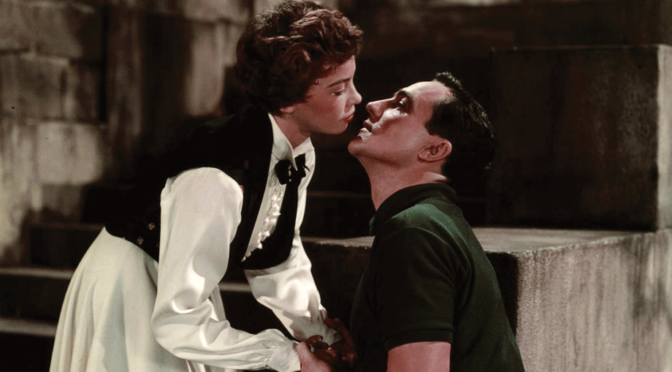
Best Picture Shame: An American in Paris
Cinema Shame comes in all shades; however, the most common variety likely has to do with well-known films that have just never presented themselves or been made a priority. I’ve never avoided An American in Paris nor have I ever made a point to track it down. I once recorded it on my DVR, but forgot to watch it. Considering the number of movies we “need to see,” many so-called essentials fall through the cracks.
For the Cinema Shame February prompt, the great minds at the Shame-Q (yes — myself included) loaded the table with unseen Academy Award Best Picture winners. All well known films, certainly. Some with more lasting power than others. I have a weekly Cavalcade (1933) Fan Club meeting every Tuesday, don’t you?
That’s an imposing list of 89 films — many of which I’m guessing are not high on anyone’s Watchlist. It’s also a fun bit of personal reckoning. How many Best Pictures haven’t you seen? (My answer is 30, which is far more than I expected and just patently unacceptable.) It also speaks to how often, time and tide re-evaluates and re-assigns value to these films. At best they live up to expectation. At worst, they’re a trace memory of a forgotten zeitgeist.
I scanned my library’s shelves for Best Picture Cinema Shame inspiration. First rack. First shelf. An American in Paris.

Knowing very little about the film itself other than the La La Land-inspiring finale, I went in largely blind — a pleasant change from most of my Shame viewings. Instead of a big, boisterous 1950’s musical, I found a small, wafer-thin narrative wrapped inside the serenity of Gershwin and the warm blanket of 1950’s Technicolor.
Gene Kelly plays Jerry Mulligan, an expatriate painter looking to enhance his reputation in Paris (#spoiler). His friend Adam (Oscar Levant), a struggling concert pianist hopes to launch a more profitable career (than tinkling the ivories in a lowly Parisian cafe) by working with the famous French singer Henri Baurel. Milo (an elegant Nina Foch), a lonely society woman takes an interest in Jerry’s work (and Jerry himself) and becomes a patron of his arts. Jerry, however, falls in love with Leslie Caron’s enigmatic store clerk Lise, complicating the patron/painter relationship. Further problematic: Lise’s engaged to Henri Baurel. Oh the tangled webs.

There’s plenty to love about An American in Paris, but the beauty’s found in smaller moments, the technical artistry of MGM in the 1950’s. Color. Set design. Photography. Gene Kelly’s athleticism. Small story. Big package. At least until the last reel when most everything comes together in a grandiose, twenty-minute finale, but we’ll come to that in a moment. The story doesn’t propel the film forward; there’s a sense of narrative listlessness as musical numbers pop in and out and occasionally arrest the film completely. All this plus some moldy 1950’s-era gender politics, contributes to some of the negative hindsight about the film.
And yet.
An American in Paris remains a charming and likable film, in no small part due to Gene Kelly’s natural charisma and Gershwin’s romantic score. Kelly, as ever, exudes joy. He is the embodiment of entertainment, selling every moment as if it’s the most fun/whimsical/romantic/downtrodden moment you’ve ever experienced. In the past I’ve seen that as both a strength and a weakness in his performance style. When it works, however, it’s magical — even if his pure strength and athleticism seems discordant with Minellii’s balletic symphony.

Now, I must make a confession within a confession. This is the Russian nesting doll of Cinema Shame posts. I’ve never cared for Leslie Caron — but I’d never seen her dance. How is that I could have wandered the depths of classic cinema but avoided the one thing that made Leslie Caron magnificent. In An American in Paris I found her positively beguiling and I could not take my eyes off her.
I have no doubt that the finale swayed Academy voters. Outside the last twenty minutes, An American in Paris isn’t even in the Best Picture conversation. As I suggested earlier, the majority of the film is an MGM confection of big budget style over substance. Jay Lerner’s script failed to analyze the potentially complex and volatile relationships between Jerry and Milo or Herni and Lise.

Then again, dissecting what made Nina Foch’s patron of the arts the most interesting character in the film would have more fully humanized her and simultaneously raised difficult questions that the film wasn’t prepared to answer. It’s about true love, mon ami, and that’s all you need to know. When a perfect, dramatic moment arises in An American in Paris, the conflict thaws and disappears just in time to preserve everyone’s happily ever after. Except Milo, who recedes silently into the background.
That said, sometimes happily ever after paired with something as magical and technically resplendent as An American in Paris‘ final reel is all we really want. The more easily that Milo slips into the background, the less we notice the frayed edges of that visual splendor.


